H-K Models 1/32 Meteor F.4
|
KIT #: |
1E06 |
|
PRICE: |
$130.00 SRP
|
|
DECALS: |
Two options |
|
REVIEWER: |
Tom
Cleaver |
|
NOTES: |
Fisher resin intakes and Life Like decals
32-013 used |
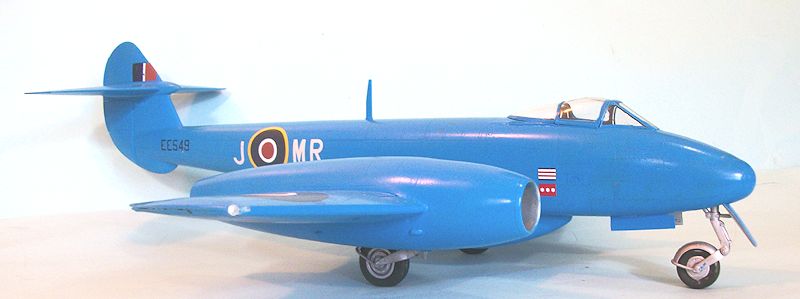
Meteor
EE549:
The
first major change in the Gloster Meteor came with the Meteor F.4, which went
into production in 1946, after the first F.4 prototype flew on May 17, 1945. The
major change with the F.4 was the use of Rolls-Royce Derwent 5 engines, which
were a smaller version of the Nene.
After a few had been produced, the wings were clipped
shorter than the F.3 with blunter tips, derived from the world speed record
prototypes.
The aircraft featured a stronger airframe, fully pressurized
cockpit, lighter ailerons to improve maneuverability, and rudder trim
adjustments to reduce snaking. The F.4 was 100 mph faster than the F.3 at sea
level (585 against 485), although the reduced-span wings impaired its rate of
climb. The new Meteor had much better performance than earlier models, reaching
570mph at 10,000ft, which was 80mph faster than the F.3. Acceleration was also
dramatically improved. The F.4 also had
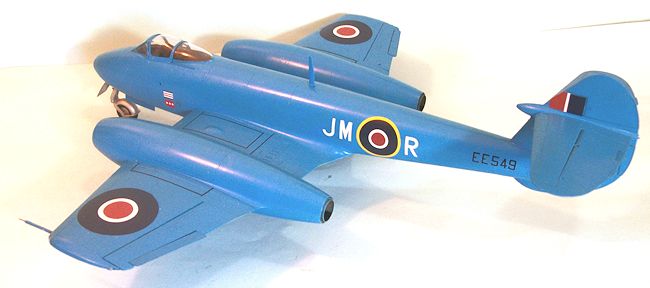 fully
harmonized controls, making it much easier to fly.
fully
harmonized controls, making it much easier to fly.
Late
in 1945, two F.3 Meteors were modified for an attempt on the world air speed
record. On November 7, 1945, Group Captain Hugh "Willie" Wilson set the first
official air speed record by a jet aircraft of 606 miles per hour at Herne Bay
in Kent.
In 1946, Group Captain Edward "Teddy" Donaldson broke this record with a
speed of 616 mph in EE549, a Meteor F.4. that had been modified by removal of
the cannon armament and strengthening of the canopy to deal with the higher
speed.
Test pilot Roland Beamont had previously taken the same aircraft to its
compressibility limit at 632 mph, but not under official record conditions, and
outside its official safety limits.
AVM
Sir James M.
Robb:
After
early service in the First World War with the Northumberland Fusiliers, James M.
Robb joined the Royal Flying Corps and became a flying ace credited with seven
aerial victories by the end of the war.
Granted a permanent commission in the Royal Air Force in
1919, he commanded 30 Squadron in the Iraqi revolt against the British in 1921.
In
1939, Group Captain Robb participated in the establishment of the Empire Air
Training Scheme, a massive training program that provided the Royal Air Force
with trained aircrew from Canada, Australia, New Zealand and Southern Rhodesia
throughout the Second World War. In January 1940 he was
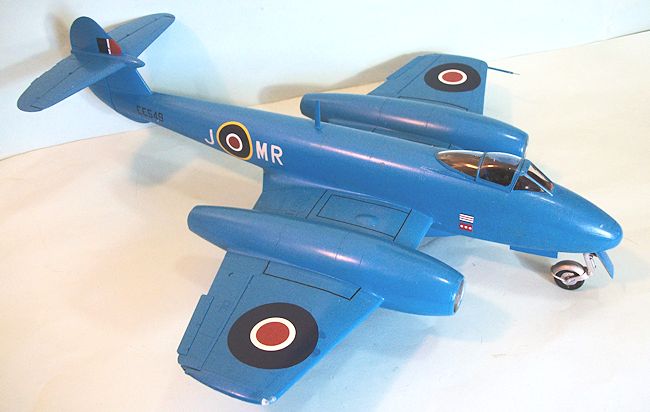 promoted to
Air Commodore and took command of 2 Group, Bomber Command in April. He held
command of the unit, which operated the Bristol Blenheim, during the terrible
battles on the Western Front in May 1940 which saw terrific losses in the
Blenheim squadrons operating in daylight.
He planned the attacks on the German invasion ports
during the Battle of Britain. In January 1941, he fell out with the head of RAF
Bomber Command, Air Marshal Sir Richard Peirse, over the merits of sending
Blenheims on unescorted daylight missions against German channel shipping, which
Robb regarded as suicidal.
He was transferred to Coastal Command, where he
commanded 15 Group, operating over the Bay of Biscay.
promoted to
Air Commodore and took command of 2 Group, Bomber Command in April. He held
command of the unit, which operated the Bristol Blenheim, during the terrible
battles on the Western Front in May 1940 which saw terrific losses in the
Blenheim squadrons operating in daylight.
He planned the attacks on the German invasion ports
during the Battle of Britain. In January 1941, he fell out with the head of RAF
Bomber Command, Air Marshal Sir Richard Peirse, over the merits of sending
Blenheims on unescorted daylight missions against German channel shipping, which
Robb regarded as suicidal.
He was transferred to Coastal Command, where he
commanded 15 Group, operating over the Bay of Biscay.
Robb
became Deputy Chief of Combined Operations under Lord Louis Mountbatten in 1942.
During Operation Torch he was air advisor to General Dwight Eisenhower; in
February 1943, Eisenhower appointed him Deputy Commander of the Northwest
African Air Forces. When Eisenhower became Supreme Allied Commander in Europe in
January 1944, he brought Robb along as Deputy Chief of Staff (Air). Robb was
promoted to Air Marshal in october 1944 and became Commander-in-Chief of Fighter
Command in May 1945, where he learned to fly the Gloster Meteor. He became
Vice-Chief of the Air Staff in 1947, and then Commander in Chief, Air Forces,
Western Union Defence Organisation in 1948. In 1951 he
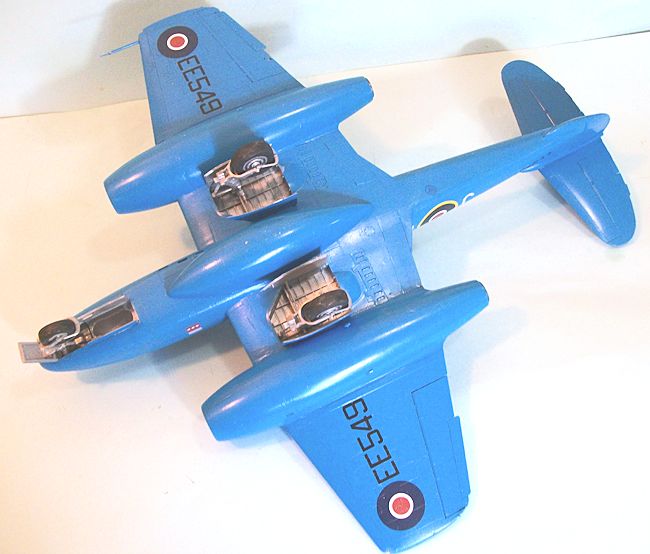 became
Inspector General of the RAF.
By the time he retired for health reasons in 1952, he
claimed to have flown over 150 different aircraft types in his career.
After retiring from the RAF, he became King of Arms of
the Order of the Bath on March 21, 1952, remaining in this appointment until
January 1965. He died at a nursing home in Bognor Regis, Sussex on 18 December
1968.
became
Inspector General of the RAF.
By the time he retired for health reasons in 1952, he
claimed to have flown over 150 different aircraft types in his career.
After retiring from the RAF, he became King of Arms of
the Order of the Bath on March 21, 1952, remaining in this appointment until
January 1965. He died at a nursing home in Bognor Regis, Sussex on 18 December
1968.
During his time as CinC
Fighter Command and in his later post-war posts, Robb was well-known for flying
his Spitfire VXI, SL721, which had a special azure blue paint scheme.
In late 1948, he discovered that EE549, the
record-breaking Meteor, had been returned to semi-operational status though it
was still unarmed.
Exercising the privilege of his position, he then
adopted the world's fastest jet airplane for his personal transport, painting
and marking it as he had the Spitfire.
H-K Models is about to
release their long-awaited Meteor F.4.
It has been discovered that the original design for the
kit managed to get the dimensions of the engine nacelles and the shape and size
of the intake wrong, confusing it with the later nacelle and intake of the late
production Meteor F.8 and the night fighters.
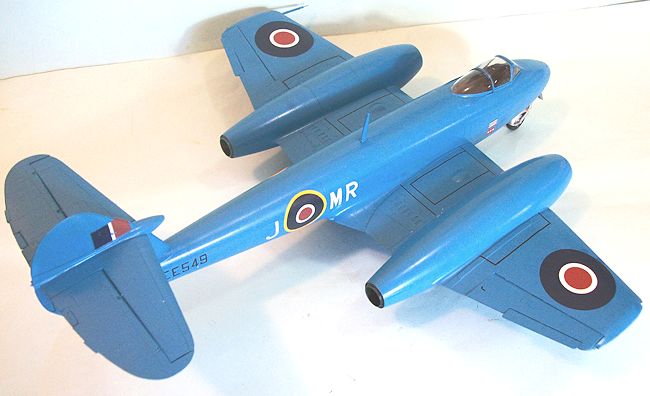 Paul
Fisher has designed and released a resin replacement intake, which results in
the proper shape and dimensions.
When I first heard of this development, I was not sure
it was really necessary, since the test shot I had built looked right to me.
However, once I had assembled this pre-release kit with
the new resin intakes, it is obvious that it results in a very different look.
Paul
Fisher has designed and released a resin replacement intake, which results in
the proper shape and dimensions.
When I first heard of this development, I was not sure
it was really necessary, since the test shot I had built looked right to me.
However, once I had assembled this pre-release kit with
the new resin intakes, it is obvious that it results in a very different look.
At
this point I will mention that Fisher Models will release a resin conversion set
to turn this kit into a Meteor F.8 in late February, with a conversion for the
Meteor F.3 following later in the spring.
Paul also has plans to do conversions for the Meteor
T.7, the N.F.11 and the N.F.14, which will allow all versions of this famous
fighter to be created.
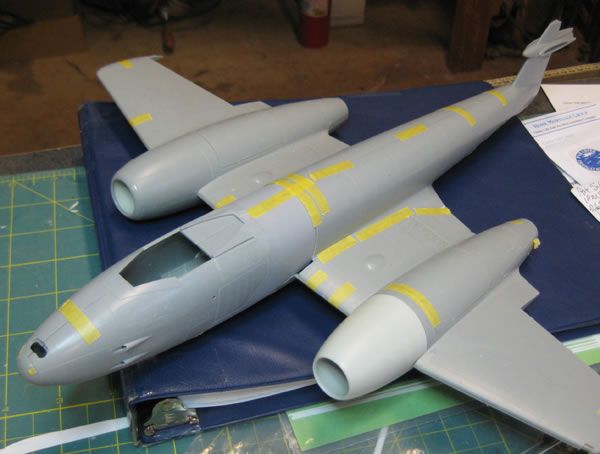 As
I noted in my previous review, assembly of the model is very easy, and made even
easier this time by my possession of the instruction booklet, which meant the
guess factor was gone.
As
I noted in my previous review, assembly of the model is very easy, and made even
easier this time by my possession of the instruction booklet, which meant the
guess factor was gone.
The
Fisher conversion set has very complete instructions for what to do.
This involves cutting off the forward section of the
engine nacelles on the kit prior to assembly of the wing, then attaching the
resin intakes once the wing has been assembled.
The intakes are a drop fit.
However, on mine I discovered that the right intake had
a flattish area on the upper right side, which I had to fix with a heavy
application of Mr. Surfacer 500 and then sanding it down smooth.
This is undoubtedly due to these intakes being test
shots, but a modeler should be careful to check this during assembly since resin
casting is really more art than science.
 I had found
a picture of EE549 when flown by AVM Robb, and thought it would give a
distinctive look to the model.
The model was painted with Tamiya X-14 Sky Blue. I
had the Lifelike Decals sheet 32-013 Supermarine Spitfire Part 4 for the Tamiya
Spitfire XVI model, which included the markings for Robb's Spitfire.
It was easy to adapt these markings for this model.
The fuselage and underwing letters and numbers for the
serials were sourced from Xtradecal sheets in the Decal Dungeon, while the
national insignia came from an Xtradecal Spitfire sheet.
I had found
a picture of EE549 when flown by AVM Robb, and thought it would give a
distinctive look to the model.
The model was painted with Tamiya X-14 Sky Blue. I
had the Lifelike Decals sheet 32-013 Supermarine Spitfire Part 4 for the Tamiya
Spitfire XVI model, which included the markings for Robb's Spitfire.
It was easy to adapt these markings for this model.
The fuselage and underwing letters and numbers for the
serials were sourced from Xtradecal sheets in the Decal Dungeon, while the
national insignia came from an Xtradecal Spitfire sheet.
While the Meteor kit
makes up into a very nice model out of the box, the addition of the corrected
resin intakes brings it right up to the peak of perfection.
January 2014
Tom Cleaver
Thanks to H-K Models for the Meteor F.4 kit.
Thanks to
Fisher Model and Pattern for the resin intakes.
Order yours at the link.
If you would like your product reviewed fairly and fairly quickly, please contact the editor or see other details in the
Note to
Contributors.
Back to the Main Page
Back to the Review
Index Page


 fully
harmonized controls, making it much easier to fly.
fully
harmonized controls, making it much easier to fly. promoted to
Air Commodore and took command of 2 Group, Bomber Command in April. He held
command of the unit, which operated the Bristol Blenheim, during the terrible
battles on the Western Front in May 1940 which saw terrific losses in the
Blenheim squadrons operating in daylight.
He planned the attacks on the German invasion ports
during the Battle of Britain. In January 1941, he fell out with the head of RAF
Bomber Command, Air Marshal Sir Richard Peirse, over the merits of sending
Blenheims on unescorted daylight missions against German channel shipping, which
Robb regarded as suicidal.
He was transferred to Coastal Command, where he
commanded 15 Group, operating over the Bay of Biscay.
promoted to
Air Commodore and took command of 2 Group, Bomber Command in April. He held
command of the unit, which operated the Bristol Blenheim, during the terrible
battles on the Western Front in May 1940 which saw terrific losses in the
Blenheim squadrons operating in daylight.
He planned the attacks on the German invasion ports
during the Battle of Britain. In January 1941, he fell out with the head of RAF
Bomber Command, Air Marshal Sir Richard Peirse, over the merits of sending
Blenheims on unescorted daylight missions against German channel shipping, which
Robb regarded as suicidal.
He was transferred to Coastal Command, where he
commanded 15 Group, operating over the Bay of Biscay. became
Inspector General of the RAF.
By the time he retired for health reasons in 1952, he
claimed to have flown over 150 different aircraft types in his career.
After retiring from the RAF, he became King of Arms of
the Order of the Bath on March 21, 1952, remaining in this appointment until
January 1965. He died at a nursing home in Bognor Regis, Sussex on 18 December
1968.
became
Inspector General of the RAF.
By the time he retired for health reasons in 1952, he
claimed to have flown over 150 different aircraft types in his career.
After retiring from the RAF, he became King of Arms of
the Order of the Bath on March 21, 1952, remaining in this appointment until
January 1965. He died at a nursing home in Bognor Regis, Sussex on 18 December
1968.

 I had found
a picture of EE549 when flown by AVM Robb, and thought it would give a
distinctive look to the model.
The model was painted with Tamiya X-14 Sky Blue. I
had the Lifelike Decals sheet 32-013 Supermarine Spitfire Part 4 for the Tamiya
Spitfire XVI model, which included the markings for Robb's Spitfire.
It was easy to adapt these markings for this model.
The fuselage and underwing letters and numbers for the
serials were sourced from Xtradecal sheets in the Decal Dungeon, while the
national insignia came from an Xtradecal Spitfire sheet.
I had found
a picture of EE549 when flown by AVM Robb, and thought it would give a
distinctive look to the model.
The model was painted with Tamiya X-14 Sky Blue. I
had the Lifelike Decals sheet 32-013 Supermarine Spitfire Part 4 for the Tamiya
Spitfire XVI model, which included the markings for Robb's Spitfire.
It was easy to adapt these markings for this model.
The fuselage and underwing letters and numbers for the
serials were sourced from Xtradecal sheets in the Decal Dungeon, while the
national insignia came from an Xtradecal Spitfire sheet.